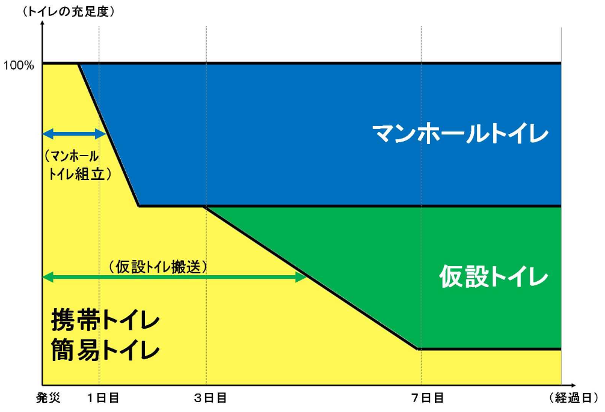1.20.2022

In preparation for a large-scale disaster, many people have already stocked up on drinking water, food, and other necessities, such as battery chargers and camping stoves, in case the electricity and water supply become cut off. But what about toilets? Compared to other emergency necessities, less than 20% of people already have an emergency portable toilet.
It may be difficult to talk about in daily conversation, but going to the toilet is just as important as eating and drinking. Hesitating to go the bathroom can lead to dehydration and heatstroke, as you refrain from drinking too much water to reduce the number of times you need to have to relieve yourself.
According to a survey conducted by Japan Toilet Labo., 39% of respondents felt the need to go to the toilet within 3 hours and 34% within 6 hours of the onset of a disaster. This rose to 92% within 12 hours with most people responding that they couldn’t last more than around half a day without using the toilet.
On the other hand, how quickly will toilets be supplied in a disaster? Using a major earthquake as an example, let's take a look at a diagram that summarizes what kind of toilets will be needed over time. (From the Ministry of Land, Infrastructure, Transport, and Tourism's "Guidelines for the Development and Operation of Manhole Toilets" (March 2021))

Emergency toilets, such as temporary toilets and vehicle-mounted toilets provided by national and local government, take time for each organization to procure and transport to the affected areas. At the time of the Great East Japan Earthquake, 34% of evacuation centers received temporary toilets within 3 days and 17% within a week.
Although there is a lot of progress being made in providing push-type support, provision of emergency toilets will still take at the least 24 hours, or up to three days depending on the scale of the disaster. Regular temporary toilets and manhole toilets that have been deployed in advance will be available at evacuation centers, but they will be few in number, and if they are the type that requires pumping, they will quickly become unusable. In other words, if you need to go to the toilet in the immediate aftermath of a disaster, sanitation support from the government will very likely be unavailable.
When thinking about your toiletry needs in the event of a disaster, you should be prepared to make your own provisions. It is necessary to have at least three days' worth, and preferably a week's worth, of portable toilets or simple toilets stocked by each person. Portable toilets are toilet bags that can be placed over Western-style toilets at home. There are many types, including those with absorbent sheets and coagulants. A simple toilet is a small carriable toilet that can be used when a toilet bowl is not available. There are types that can be used by covering the toilet bag of a portable toilet, and others that are mechanical. Some mechanical toilets cannot be used unless electricity is available, so be careful.
According to the Japan Toilet Association, the number of times an adult should go to the toilet a day is about 5 times. For a family of four, for example, a three-day supply would be 5 times x 4 people x 3 days, or 60 times, and a weekly supply would be 5 times x 4 people x 7 days, or 140 times. (5 times x 4 people x 7 days) 140 times. It may seem like a lot, but some emergency toilet products come in compact boxes and can be stored for a long time, so it is a good idea to stock up in advance.
Earthquakes are not the only cause of problems with drains and sewers and related sanitation issues. In the event of large-scale flooding, drainage problems may persist for a long time. Some of you may be thinking of evacuating your homes due to concerns about infectious diseases. Along with water, food, and charging devices, you should also prepare an emergency toilet.

